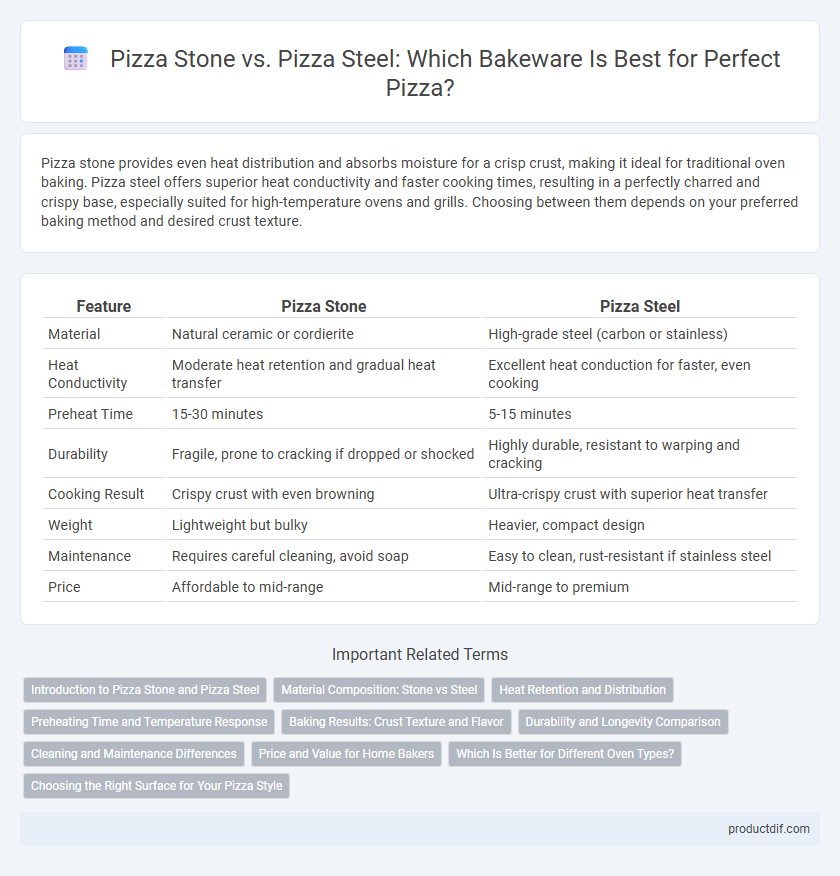Pizza stone provides even heat distribution and absorbs moisture for a crisp crust, making it ideal for traditional oven baking. Pizza steel offers superior heat conductivity and faster cooking times, resulting in a perfectly charred and crispy base, especially suited for high-temperature ovens and grills. Choosing between them depends on your preferred baking method and desired crust texture.
Table of Comparison
| Feature | Pizza Stone | Pizza Steel |
|---|---|---|
| Material | Natural ceramic or cordierite | High-grade steel (carbon or stainless) |
| Heat Conductivity | Moderate heat retention and gradual heat transfer | Excellent heat conduction for faster, even cooking |
| Preheat Time | 15-30 minutes | 5-15 minutes |
| Durability | Fragile, prone to cracking if dropped or shocked | Highly durable, resistant to warping and cracking |
| Cooking Result | Crispy crust with even browning | Ultra-crispy crust with superior heat transfer |
| Weight | Lightweight but bulky | Heavier, compact design |
| Maintenance | Requires careful cleaning, avoid soap | Easy to clean, rust-resistant if stainless steel |
| Price | Affordable to mid-range | Mid-range to premium |
Introduction to Pizza Stone and Pizza Steel
Pizza stones and pizza steels are essential bakeware tools designed to enhance homemade pizza quality by providing even heat distribution and a crisp crust. Pizza stones are typically made from ceramic or cordierite, retaining heat to simulate a brick oven's effect, while pizza steels are composed of steel, offering superior thermal conductivity for faster, more consistent baking. Both options significantly improve crust texture and bake time compared to traditional baking sheets.
Material Composition: Stone vs Steel
Pizza stones are typically made from ceramic, cordierite, or clay materials that retain heat evenly and absorb moisture to create a crisp crust. Pizza steels, made from solid steel, offer superior thermal conductivity, allowing faster heat transfer and higher cooking temperatures for a quicker, evenly cooked pizza base. The choice between stone and steel influences cooking performance, with stone providing moisture absorption and steel delivering rapid heat conduction.
Heat Retention and Distribution
Pizza stones excel in heat retention due to their thick ceramic or cordierite material, which absorbs and radiates heat evenly, resulting in a crispy crust. Pizza steels outperform stones in heat distribution because their high thermal conductivity rapidly transfers heat to the dough for quicker cooking and better oven spring. Choosing between the two depends on whether consistent heat retention or faster, even heat transfer is the priority for your pizza baking.
Preheating Time and Temperature Response
Pizza stones typically require longer preheating times, often 30-45 minutes, to reach optimal cooking temperatures due to their ceramic composition. Pizza steels conduct heat more efficiently, allowing for faster temperature response and shorter preheating times, usually around 15-20 minutes. This rapid heat transfer in pizza steels results in crispier crusts and more consistent baking temperatures compared to pizza stones.
Baking Results: Crust Texture and Flavor
Pizza stones offer excellent heat retention and distribute heat evenly, resulting in a crispy, well-cooked crust with a slightly smoky flavor. Pizza steels conduct heat faster and provide higher temperatures, producing a crust with superior crispness and pronounced charring, enhancing overall flavor complexity. Both materials improve baking results, but steel excels in achieving a restaurant-quality crust texture and enhanced flavor depth.
Durability and Longevity Comparison
Pizza steel outperforms pizza stone in durability due to its high resistance to cracking and chipping, offering prolonged usability even under frequent high-temperature baking. Pizza stones, typically made from ceramic or cordierite, are more prone to breakage from thermal shock or accidental drops, limiting their lifespan. Despite this, pizza stones provide excellent heat retention but require careful handling to maintain longevity compared to the robust, long-lasting nature of pizza steels.
Cleaning and Maintenance Differences
Pizza stones require careful cleaning by avoiding soap and soaking to prevent cracking, while pizza steels are easier to maintain with simple wiping and occasional seasoning. Stone's porous surface can harbor food residues and moisture, demanding thorough drying to avoid mold growth. Steel's non-porous surface resists stains and odors, making it more durable and hygienic over time.
Price and Value for Home Bakers
Pizza stones typically range from $20 to $50, offering affordable heat retention for home bakers seeking crispy crusts. Pizza steels, priced around $60 to $120, provide superior heat conductivity and faster cooking times, delivering higher value despite the upfront cost. Investing in pizza steel often results in better baking performance and durability, making it a cost-effective option for serious home bakers.
Which Is Better for Different Oven Types?
Pizza stones excel in traditional ovens by providing even heat distribution and absorbing moisture, resulting in a crispy crust. Pizza steels are ideal for high-temperature ovens and broilers due to their superior thermal conductivity, producing faster and more intense heat transfer for a perfectly charred crust. Gas ovens benefit from pizza stones' heat retention, while electric ovens and grills often pair better with pizza steels for rapid heat response.
Choosing the Right Surface for Your Pizza Style
Pizza stone absorbs moisture, creating a crisp, evenly baked crust ideal for traditional Neapolitan or thin-crust pizzas, while pizza steel offers superior heat conductivity, delivering faster cooking times and a charred, pizzeria-style crust perfect for thick or New York-style pizzas. Consider your oven's maximum temperature and pizza thickness when selecting the surface to achieve optimal results. Choosing between pizza stone and pizza steel hinges on your preferred crust texture and baking speed.
Pizza Stone vs Pizza Steel Infographic

 productdif.com
productdif.com